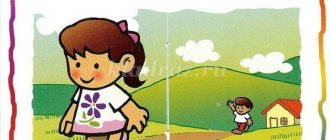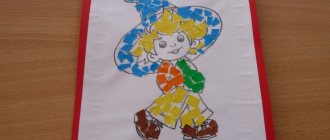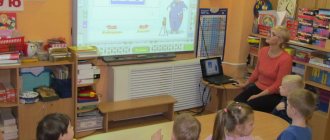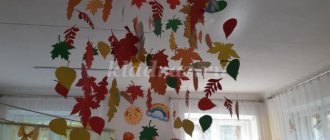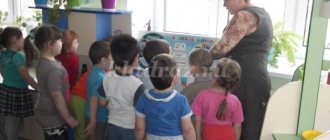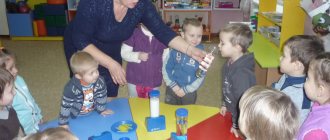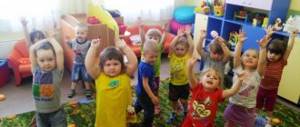Summary of GCD in the junior group “Visiting Spring”
Lesson in the younger group on the topic: Spring
I bring to your attention a summary of educational activities for children 2-3 years old.
This summary will be useful for teachers of younger groups. The lesson can be held in group rooms, music halls. This development systematizes children's ideas about the season - spring, reinforces the ability to observe natural phenomena and establish simple connections between them. The activity develops thinking, attention, fine motor skills of the fingers, artistic and creative abilities of the child. Develops a caring attitude towards nature and accuracy when doing work. During the lesson, children read poems by heart, and memorizing poems is a kind of, and very intense, useful gymnastics for the brain, developing memory and attention. This is a replenishment of vocabulary, even the simplest children's poem contains many words that we do not often use in everyday life . And the speech structures themselves in a poetic text are much more complex and interesting than in everyday life. A child, repeatedly reciting a poem, activates a whole layer of complex vocabulary, his speech becomes richer and more complexly organized. This lesson includes finger games - this is the staging of any rhymed stories or fairy tales using the fingers. The child develops perseverance, listening skills, speech activity increases, and memory develops. Breathing exercises in this lesson have a positive effect on the functioning of the respiratory, cardiovascular, and nervous systems of the body. Summary of direct organized activities in the junior group of the kindergarten “Visiting Spring”
Objectives: Systematize children’s ideas about the season - spring. Strengthen the ability to observe natural phenomena and establish simple connections between them. Educational: consolidate and clarify ideas about the signs of spring; learn to find signs of spring in pictures yourself; expand your vocabulary; learn to move in accordance with the words of games and nursery rhymes; Developmental: develop thinking, attention, fine motor skills of the fingers; artistic and creative abilities; sense of rhythm; ability to change the strength of the voice - speak quietly - loudly; Educational: to cultivate a caring attitude towards nature, accuracy when doing work. Materials for the lesson: large yellow circles made of cardboard (sunbeams), cotton balls (snowball), a large picture of a stream, clouds; pictures of trees, flowers, grass, sun, bicycle, snowflakes, sleighs, snowman, paper boats; image of the sun, rays on Velcro; sheets of paper with applique of bushes, white plasticine, napkins, boards for modeling. Progress of the lesson: Educator: Today is an unusual day, I want to surprise you. We're going on a big adventure now.
Tell me guys, what time of year is it now? (Spring.) That's right, spring. Spring struggled for a long time with winter. Winter didn't want to go away. Spring sent its helpers to us - sunbeams, and winter brought a snowball. The sunbeams stopped on our table. Let's blow on the snowballs so that they roll towards the bunnies and melt. And spring will come faster. Breathing exercises “Blow on a snowball” Blow hard, then softly, long and short, puffing out your cheeks without puffing out your cheeks.
Educator: Well done, guys! Good job, all the snowballs have melted! Now let's ask the sun to warm the earth and spring will come quickly! "Finger gymnastics." We stretched out our palms and looked at the sun. Give us some warmth from the sun, so that we can have strength. Our little fingers don't want to wait a minute. Clap-clap with your arms, Stomp-stomp with your legs, Jump-jump like bunnies, Jumping on the lawn. “Signs of Spring” Guys, how well do you know the signs of spring? Help me find them. Take pictures depicting signs of spring. (Sun, grass, flowers, bicycle, paper boats, etc.) We add pictures suitable for winter to the spring pictures: snowflakes, sleighs, snowman. (Children post pictures in a large picture depicting the sun, grass, flowers, birds, and a bicycle). Educator: Do you love the sun? (Children, yes!) It’s so nice when it shines, our mood becomes better. Let's give the sun a song. Children perform the song “Sun” (lyrics by E. Makshantseva, E. Kotysheva, music by E. Makshantseva), performing movements in accordance with the text.
Educator: This is our sunshine. (Image of the sun without rays) But it’s just not funny, it’s missing something. (Children: rays!) That's right, it doesn't have rays. Let's give some rays to the sun. (Children attach the sun's rays to the sun with Velcro) Look, the sun is smiling. It thanks you for helping it and giving it rays of light! And the sun really liked how you sang the song and invites you to play. Game "Sunshine and Rain". The sun looks out the window and shines into our room. We will clap our hands - We are very happy about the sun. Productive activity “Let’s give willows to Spring” Educator: Guys, let’s give willow bushes to Spring! Our bushes are now bare, and we will decorate them with willows. (Teach children to tear off small pieces of plasticine, roll them between their palms, and, using pressure, flatten them with a finger from above, attaching them to a sheet of paper on which a bush is depicted)
Educator: Well done, guys, your willow bushes turned out very beautiful. Do you know spring poems? (Children read poetry) Educator: And now we invite everyone to dance. Dance “Rosy Cheeks” 1) Babies, babies, Pink cheeks, And with us, and with us, Sounding claps!
2) Babies, babies, Pink cheeks.. And we have fists, Like hammers. 3) Babies, babies, Pink cheeks! And with us, and with us, it’s fun in the garden. 4) Babies, babies, Pink cheeks! And with us, and with us, our mouth is locked!
Educator: There are no more difficult tasks, we were able to complete everything. Winter said goodbye to us, allowing spring to come. Having finished the adventure, we return back to our beautiful, to our good To our beloved kindergarten The teacher comes out, in a spring costume, thanks the children for bringing her arrival closer and gives the children a treat - sweet cockerels on a stick.
We recommend watching:
Observation during a walk in the second junior group in the spring Summary of educational activities in the 1st junior group on the topic: Spring Summary of a game lesson on speech development in the junior group “Journey to the spring forest” Plan of a summary of educational activities in the field of “Cognitive Development” in accordance with the Federal State Educational Standard
Similar articles:
Spring physical education in the younger group. Scenario “Journey to the Spring Forest”
Summary of a spring walk in the junior group of a preschool educational institution
Outdoor games for a walk in the younger group in the spring
Summary of GCD in the second junior group on the topic: Spring
Summary of a complex lesson (cognition and artistic creativity) in the second junior group on the topic: “Hello, guest, Spring!”
Author: Ignatievskaya Olga Ivanovna, teacher of MBDOU kindergarten No. 3 “Forget-Me-not”, Protvino Objectives: To consolidate children’s knowledge about the characteristic signs of winter and early spring. Form children's ideas about spring changes in nature: more sunny days, it becomes warmer, snow melts, thawed patches appear, children's clothes change, birds arrive, etc. Continue to teach children to smear plasticine on cardboard using a pressing movement of the index finger, develop an interest in working with plasticine, and develop fine motor skills. Develop speech, imagination, creative and mental abilities of children. Improve communication skills. Cultivate a caring attitude towards living nature, a desire to carefully complete the work started. Vocabulary work: spring, March, thawed area, thaw, stream, icicle, sun, rays, drops, snowdrop, bud; early, long-awaited, bright, sonorous, fragile, transparent; murmurs, darkens, melts, swells, arrives, bakes, shines, etc. Materials: large pictures of winter and spring, small pictures of the seasons, an envelope, a sketch of the sun and clouds, yellow plasticine, sheets of blue or light blue cardboard in A5 format, boards, napkins. Preliminary work: Observations in nature, looking at illustrations, reading fiction, listening to music and the voices of nature, active, didactic and verbal games.
Progress of the lesson
Children sit on chairs in front of the board.
Educator : Someone threw me at the window, Look at the letter. Maybe it's a ray of sunshine that tickles my face? Maybe this little sparrow dropped it while flying? Who did the letter come from? You want to know, right? Then you have to try, you can guess the riddles! (Take the envelope.) Educator : Let's open the envelope and guess the riddles: There is a scarlet ball in the blue sky, It is bright and hot. (Sun.) White carrots grow in winter, And when the sun warms up, bitter tears flow. (Icicle.) The snowball is melting, the meadow has come to life, the day is coming. When does this happen? (In spring.) I invite the children to go and sit on chairs. Educator: That’s right guys, it’s spring. Look at these illustrations and tell our guests what they show. What time of year is it in this picture? (Winter.) Educator: What do we see on it? (There is a lot of snow, children are sledding, the trees are bare, children are dressed warmly, etc.) Educator : What time of year is shown in the second picture? (Spring.) Educator: In what subjects did you guess that it was spring? (The sun is shining brightly, icicles, streams, thawed patches, birds have arrived, etc.) Educator : What is spring like now? (Early.) Educator : Let's play the game “Wonderful Bag”. Look at my bag, there’s something in it! Want to know what's in it? I'll tell you a secret that it contains a lot of small cards with pictures. You will come up to me, take out one picture at a time and name what is drawn on it and what time of year it happens. You need to put winter pictures on the field where winter is depicted, and spring pictures - for spring. (Children take turns coming up, taking a small picture, calling what is drawn on it and relating it to the time of year.) Educator : Guys, name again the signs of early spring. (The sun is warming up, the snow is melting, streams have appeared, icicles are hanging from the roofs, thawed patches, the day has become longer, the night is shorter, birds are flying in, children and adults have put on light clothes, a warm wind is blowing.) Educator: Guys, listen. What is this? The phonogram “Drops” plays. Is someone crying? Did you guess it? Drip-drip-drip... (Icicles cry, drip, melt.) Educator : Why are they crying? Did someone offend them? (No, they cry because they are melting. And they are melting because the sun is warming, it has become warm.) Educator: That’s right, guys! Look, the sun is shining through our window. Let's take a little rest. Physical education lesson: (With the help of a mirror I turn all the children into sunbeams.) I read a poem by A. Brodsky: Runners are jumping - sunbeams. (Children jump on two legs in place.) We call them, but they don’t come. (They stand, beckon with their hands, shake their heads.) They were here - and they are not here. (They shrug, surprised.) Jump, jump around the corners. (They jump all over the floor.) They were there - and they are not there. (Point with hands.) Where are the bunnies? Gone. Haven't you found them anywhere? (Hands to the sides, surprise, shrug.) Educator: Okay, we played with the sunbeams. Guys, let’s make a lot of suns with you so that the group is always sunny and joyful: Nature has come to life around us, Awakened from sleep. From the blue sky Spring has come to us with the sun! I hang the painted sun on the easel. I invite the children to sit at the tables. Educator: Guys, what does the sun look like? (For a ball, a circle, a fire, a flower, etc.) What color is it, honey? Where would you start creating a sun? Look, I have a sun, but you don’t have one yet, let each of you create a sun for yourself, and then our group will be even brighter. Demonstration of how to sculpt a sun - roll a ball in a circular motion, flatten it with your palms to form a disk. Then place the disk in the center of the sheet and, using your index finger, placing it in the middle of the disk, pressing, pull the rays to the sides. The phonogram “Early Sun” plays.
Children create the sun by smearing plasticine on a sheet of paper with their fingers.
Educator: What beautiful suns you have made. Let's take a look at them. — How many suns did we get? (A lot.) - How much is there in the sky? (One.) - What color is the sun? (Yellow.) - I really liked your suns, and the group became even brighter and more joyful from the sunlight. Well done boys! Summing up the lesson. - What time of year were we talking about today? (About spring). — What signs of spring do you remember? (The sun is warming up, the snow is melting, streams have appeared, icicles are hanging from the roofs, thawed patches, the day has become longer, the night is shorter, birds are flying in, people are wearing light clothes, a warm wind is blowing.) - What did we sculpt today? (Sun.) - How did the suns turn out? (Beautiful, yellow, bright, warm, etc.) Educator: Everyone tried their best today. Well done! Literature: 1. E.A. Alyabyeva “Thematic days and weeks in kindergarten”, Moscow, Tvorchesky, 2012. 2. O.A. Voronkevich “Welcome to ecology!”, St. Petersburg “Childhood-Press”, 2007. 3. “Integrative cognitive activity of younger preschool children”, ed. V.A. Derkunskaya., Moscow, “Center for Pedagogical Education”, 2013.
We recommend watching:
Summary of GCD on gender education in the 2nd junior group. Summary of GCD in the second junior group. Synopsis of GCD in the 2nd junior group. Fun Train Summary of an open lesson for children of the second junior group
Similar articles:
Math lesson notes. Topic: “First - then.” Second junior group
